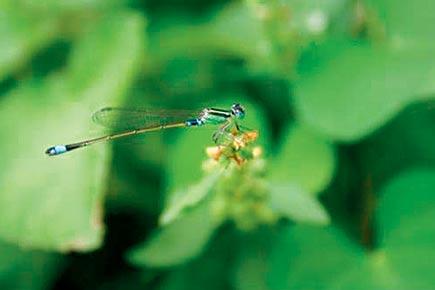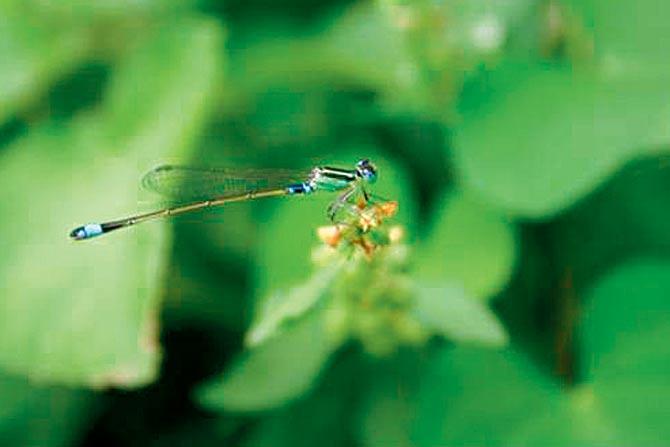Last week, I spent three exceptional days in the heartland of Kerala, at the Dr Salim Ali Wildlife Sanctuary (Thattekadu), with 35 nature enthusiasts from across the country and one gent from the island country of Sri Lanka.

The lesser-appreciated of the Odonate specieis u00c3u00a2u00c2u0080u00c2u0094 the damselfly
 Last week, I spent three exceptional days in the heartland of Kerala, at the Dr Salim Ali Wildlife Sanctuary (Thattekadu), with 35 nature enthusiasts from across the country and one gent from the island country of Sri Lanka. Among those gathered, were a few Mumbaikars, like me, who were passionate about nature and carried the conservation flag high over our heads. However, there was a deeper point of commonality among all of us — we were all studying or were interested in the protection of Odonates, commonly called dragonflies and damselflies.
Last week, I spent three exceptional days in the heartland of Kerala, at the Dr Salim Ali Wildlife Sanctuary (Thattekadu), with 35 nature enthusiasts from across the country and one gent from the island country of Sri Lanka. Among those gathered, were a few Mumbaikars, like me, who were passionate about nature and carried the conservation flag high over our heads. However, there was a deeper point of commonality among all of us — we were all studying or were interested in the protection of Odonates, commonly called dragonflies and damselflies.
Odonates are an important group for study and monitoring as they have been around on our planet way before the dinosaurs arrived (250 million years ago). Back then, the planet faced inhospitable temperatures of over 180-200 degrees Celsius, atmospheric oxygen levels were low, and high levels of carbon dioxide and sulphurous gases emerged from hundreds of active volcanoes. As vascular (green) plants arrived on the scene, and began converting carbon dioxide into oxygen, a larger variety of life began colonising both water and land. The Odonates too experienced an initial enlarging in size, and then, with plenty of oxygen, their bodies reduced to present day forms, which are largest at 19 cm wingspans and 13 cm body lengths.
ADVERTISEMENT

The lesser-appreciated of the Odonate specieis — the damselfly
It is shocking that although found world over, except in Antarctica, the dainty damselflies have hardly etched a special place in literature, art, history or folklores of the world. Ecologists and climate change researchers hold the damselflies in high esteem as ecological indicators and biological pest-controllers. Their aquatic larvae (nymph) and adults feed on insect pests such as fleas, gnats, midges, flies or mosquitoes, which transmit diseases such as dengue and malaria.
Looking for prey, they gently hover around over gurgling streams. But they also avoid their predators, such as bee-eaters, spiders, other dragonflies or damselflies and frogs. It will not be an exaggeration to state that these benign and gentle creatures are the controllers of our aquatic ecosystems and, hence impact our agricultural outputs too.
For those concerned with climate change, these Odonates who have survived four Ice Ages are now facing extermination due to detergents, phenyls, petro-chemicals leaking out of vehicles and boats, dumping of industrial wastes and urban sewage. But walk around Bandra or Sion Talao, or any other water body in Mumbai with a grassy, tree-lined or herbaceous edge, and you will literally see hundreds of tiny needle-bodied damselflies hovering about. Their body colours, wing patterns, effortless flights and hunting expeditions are a great delight to watch.
Mumbai is lucky to host nearly 50 different damselflies. The ponds inside Bhavan’s College or at Maharashtra Nature Park, and streams inside Ismail Yusuf College and Pherojshah Nagar (Vikhroli) harbour tiny dartlets, camouflaging spread-wings and many glistening varieties of damselflies, hunting for aquatic invertebrates, fish fry and tadpoles to hunt. They are a photographer’s delight; once you click them, you’ll be tempted to make them your profile picture or even print calendars and greeting cards.
For a tiger-crazy country like India, damselflies seem insignificant and unimportant. But urban planners, medicos, ecologists and economists would agree that if we don’t want to run huge hospital bills and epidemic outbreaks, then we should invest in the protection of our wetlands and damselflies.
It will be an epic failure of mankind and of intelligent Mumbaikar’s if we lose our floating damsels. It’s time schools, colleges and housing colonies take effort to clean up our freshwater bodies and show some concern for these damsels in distress.
 Subscribe today by clicking the link and stay updated with the latest news!" Click here!
Subscribe today by clicking the link and stay updated with the latest news!" Click here!







